Ten years ago, by local decree, “South Central” became “South L.A.”
The name change represented City Hall’s effort to halt the stigmatization of an area that had put up with gangs, shootings, urban blight, diminished resources and poverty for decades.
Some called the change a foolish move that would only bring superficial change. Others took offense, saying they were proud of their “‘hood” roots. All the while politicians like Jan Perry and Mark Ridley-Thomas said the new moniker could give the neighborhood a much-needed boost. One resident (from Vermont Square, to be precise) said the media had made “South Central” synonymous with urban poverty. She told the Los Angeles Times:
“Anything bad happens, you get on TV, and the first thing you say was ‘South Central.'”
Today, city officials along with mainstream media and many Angelenos call the collection of neighborhoods south of the 10 freeway “South L.A.”
If a name can carry as much weight as the proponents for the change seemed to believe, then it’s time for a check-up. How does a name affect the way people see South L.A. — both looking in and looking out? And what can we learn about developments in South L.A. over the past ten years just by asking about a name?
View South Los Angeles in a larger map
_________________________________________________________________________________________
_________________________________________________________________________________________
A decade after the name change experiment began, Intersections wants to take the pulse of the city. We are asking Angelenos of all stripes to let us know what they think. Scroll down to read comments from city officials, organizers, workaday moms and dads, writers, educators, students, seniors, youth and others, and check back soon for more.
And we want to hear from you! Please write your thoughts below to join the discussion. Every week we’ll feature new responses at the top of this page. Questions or comments? Email [email protected].
_________________________________________________________________________________________
_________________________________________________________________________________________
JOSH SIDES
Professor of history at Cal State Northridge
I take it on faith that there were many people for whom the name change meant something really important. It meant that they had shed this stereotype of a community in endless violence, unemployment, poverty, dysfunctional families, drug abuse and all that. So, the psychological benefits that residents derived from that is not something anyone has measured, and I can only imagine that they’re fairly substantial. But I cannot make the connection between the psychological benefits and the material changes. The material changes are happening entirely on a separate track from that psychological benefit.
Sides teaches at Cal State Northridge and is also a writer and editor. The quote above is an excerpt from the full interview with Intersections.
OSCAR MENJIVAR
Founder/CEO, Urban Txt
I think “South Central” brings a sense of community for the people who grew up in South L.A. I never felt that it was such a bad place to live. It was portrayed very differently in the movies, it was portrayed bad. If anything, “South Central” is a sense of pride, and sense of community. A place where people grew up with similar issues, similar challenges. I’ve overcome great challenges, and I’ve done amazing things.
My question would be: What were the goals of changing the name to South L.A? Was it to change the stigma South L.A. had? Have we accomplished that? And if so, how? And by changing the name to South LA, who did it benefit most?
What do you see as an important issue now in South L.A.?
There’s a big access divide to technology. If you look at the trends in education right now, there’s lots of trends moving to online systems. Well, if I’m a kid in South A. and I don’t have Internet access, but my teachers are telling me I need to study online, then how do I get that? The access to high-speed Internet affects education, economic empowerment, and access to information to be able to be knowledgeable about what’s happening in your community. I want our kids in South LA to be able to create with technology — not just to consume information, but to create media pieces, to create apps, to create websites. || Daina Beth Solomon
Menjivar’s “hackerspace” for Urban Txt is slated to open in the summer of 2014. To learn more about his organization, read an article from Intersections: “South LA teens code their way to success by learning technology basics.”
EMORY HOLMES II
Writer
I used to hate it when I would hear people, mostly white newscasters, when they would refer to any place where Black people lived … as South Central.
What they were saying is, this event is associated with Black life, Black depravity, Black hopelessness, Black despair, Black crime, Black poverty. Any time you heard someone say ‘South Central,’ what they were actually trying to evoke was the goblin of Black horror. || Sinduja Rangarajan
Click to hear more from Emory Holmes:
Emory Holmes II is a Los Angeles based playwright, novelist, poet and journalist. His news stories have appeared in the Los Angeles Times, San Francisco Chronicle, The Los Angeles Sentinel and other news outlets across the country. He is author of novels “Black Rage” and “Sunday Hell,” while his crime stories have appeared in three anthologies: “The Cocaine Chronicles,” “The Best American Mystery Stories 2006,” and “Los Angeles Noir.”
ELZA GONZALES
Resident
“South Central” — that’s the way I’ve known it. South Central, the ghetto. People get scared when you say South Central. The only difference [between South Central and South L.A.] is that when you hear South Central you think it’s all about gangs, criminals, and violence. South L.A. is like the buildings, all the good views, all the good stuff that people come and see, that the tourists come and see. But if you go to South Central you see something else. You’ll see violence. That’s the way I see it. But I live in South Central, not South L.A. || Ashley Hansack
TANIA CORTES
Resident
I call it “home” because that’s where I grew up. Because that’s where my family is. That’s where I live. I wouldn’t move out of L.A. Everything’s here. Every freeway that you want to go, each direction is all around Downtown L.A. and South Central. There are beaches about 20 miles away. Disneyland the other way. Hollywood. Why would you move out? Everything’s here. That’s why people are here. || Ashley Hansack
ERNESTO GALLARDO
Resident
I call it “South Central” because that’s how it’s always been called. They started saying that South Central was a negative term for “South Los Angeles.” People were saying that it was ghetto and all this. I think it’s bullshit… If you ask me where I’m from I’ll say South Central. I’m not ashamed of where I live, I don’t need to sugarcoat anything. I think that’s what it is. South L.A. is just sugarcoated for South Central. You feel me? I think ultimately the hood is going to be the way the people make it. || Ashley Hansack
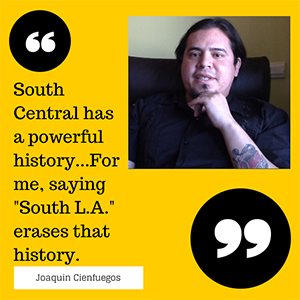 JOAQUIN CIENFUEGOS
JOAQUIN CIENFUEGOS
Organizer, CopWatchLA
I call it “South Central” because I grew up here. To me, “South L.A.” always meant south of South Central. South Central goes all the way into Watts. Once you get into Compton, the South Bay, Huntington Park, or the Southeast, to me, that was South L.A.
South Central has a powerful history. Since many people migrated here from the South or moved here from Mexico, their struggles intersected. And I think this community is one of the only areas where you don’t see animosity or tension between black and brown folks. Especially for young people, because they grow up together. You have black youth that listen to rock en espanol, or Chicano youth who are into hip hop. The culture here in South Central is more mixed. For me, saying “South L.A.” erases that history. || Daina Beth Solomon
 LINA FRAUSTO
LINA FRAUSTO
Resident
I’ve never heard anyone call “South Central” “South L.A.” until today. I do therefore believe it is a superficial action because it seems that it is dividing the community more than anything. …Compton and Inglewood supposedly aren’t included in the South L.A. line divide and those are two of the most affluent POC [people of color] communities that were once grouped in with South Central. || Skylar Endsley Myers
Lina Frausto is a 24 year old from Watts who has spent most of her adult life in New York City.
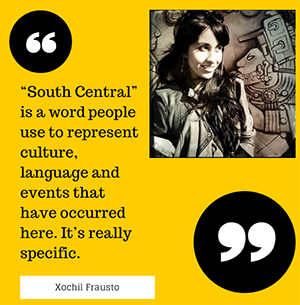 XOCHIL FRAUSTO
XOCHIL FRAUSTO
Intersections South LA Reporter Corps
“South Central” is a word people use to represent culture, language and events that have occurred here. It’s really specific. “South L.A.” is kind of like, ‘let’s forget about all of that and sort of pacify what has occurred in the area.’” || Skylar Endsley Myers
Xochil Frausto is a 24-year-old Watts Native who now lives in Oakland.
EDWARD PROKOP
Captain, LAPD Newton Division
The name change is one piece of that pie of how the community has changed. Certainly, violent crime is not what it was in 2003. The entire neighborhood changed. How we do policing changed, how we do outreach changed, how we do partnerships has changed. Collectively, all of this is having an impact. The name change, I don’t know how much weight that carries, but it happened at a time when everything started to change. You can’t discredit one thing; many things have had a fight in our success here. || Daina Beth Solomon
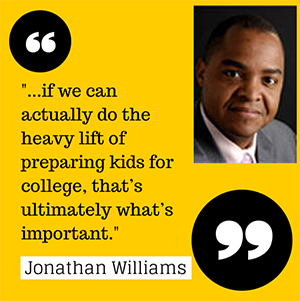 JONATHAN WILLIAMS
JONATHAN WILLIAMS
Founder and CEO, The Accelerated Schools
I’ve worked in South L.A., and what’s considered South Central, since 1990. And as much as it is associated, nationally as well as internationally, with crimes and drugs and bad things, I have learned to appreciate South Central.
There are wonderful people here. I feel I have a moral obligation, through the school as well as through all of our relationships, to elevate that story. We need to work as hard at capturing the great things as focusing on the murders and drive-bys.
Cosmetics like names are important, because they can inspire and capture value. But at the same time, if we can actually do the heavy lift of preparing kids for college, that’s ultimately what’s important. || Daina Beth Solomon
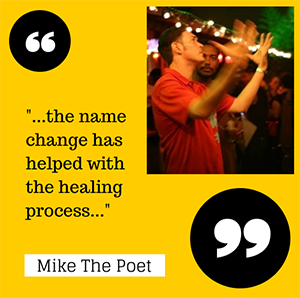 MIKE THE POET
MIKE THE POET
I think that the name change has helped with the healing process and helped with improving South Central’s image. But names alone can’t change much and I am sure old-timers would miss “South Central.” || Sinduja Rangarajan
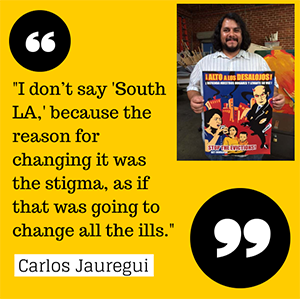 CARLOS JAUREGUI
CARLOS JAUREGUI
Organizer, Strategic Actions for a Just Economy
I say South Central. I think it’s the appropriate name for the culture, which can actually go beyond the bounds of Historic South Central. Historic South Central is just a small piece. But the similarities of the culture extend through the entire area south of the 10 to the 105, and Crenshaw to Alameda. It’s difficult to distinguish one neighborhood from the other. They all have their own little quirks, but a lot of the issues, and the people and the culture, are the same. And the reason they changed the name, I guess because of the stigma “South Central” had, affected the entire area.
I live in Gramercy Park. If you ask me where I live, outside of South Central, I’ll say South Central. If people in South Central ask, I say Gramercy Park.
I don’t say “South L.A.,” because the reason for changing it was the stigma, as if that was going to change all the ills. I believe the way to address it is through politicians and developers and activists.
I’ve never heard a Latino or any immigrant call it South L.A.. It’s “sur centro.” The people that I hear call it “South L.A.” the most are people that don’t live there. Or, the people that do live there are the politicians, and the developers. I think it’s just white-washing. || Daina Beth Solomon
_________________________________________________________________________________________
_________________________________________________________________________________________
We want to hear your perspective! Write your thoughts below to join the discussion.
_________________________________________________________________________________________
_________________________________________________________________________________________










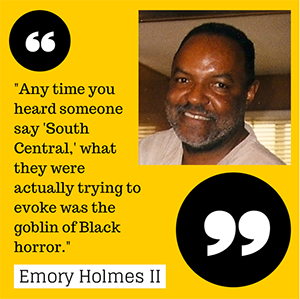

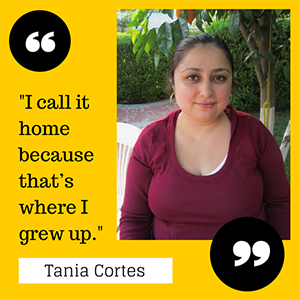
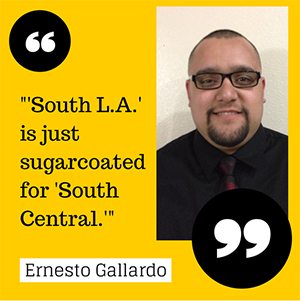
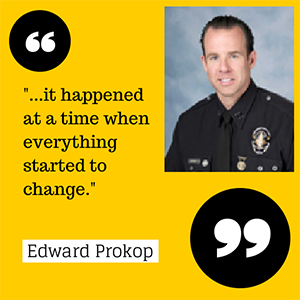





I’ve lived on Adams/Central all my life (36yrs) and with 3 teenagers now, myself, I proudly tell the stories to them of what this neighborhood USED to be. Yes, I am proud to say that I was raise in South Centra L.A.l! But it also makes me proud that we have come all this way and that now South L.A. is where my kids grew up. The streets are safer and there is less graffiti. I remember gun shots/drive bys, everyday all day, from one corner to the other. I am glad my kids have never witnessed that gun battle.
Thanks, Katy! Great to hear your thoughts.
Great perspective Katy. Glad you could share that!
“South Los Angeles” isn’t, by any means, a new designation. It’s the original designation for the area… as anyone who reads old books, watches old movies or television shows, or listens to old radio dramas set in Los Angeles can attest — or, for that matter, anyone who’s old enough to remember Los Angeles from before 1948.
It seems that most people’s notions of history begin with their own memory which is why you hear the refrain of “that’s how it’s always been” when what people really mean is “that’s what I remember from my childhood experience and anything else is irrelevant to me.”
For those who weren’t there (myself included) before 1948, South Central referred exclusively to the black neighborhood along South Central Avenue (hence the name) where most black Angelenos were forced to live before the US Supreme Court said otherwise. After desegregation, as black Angelenos moved into new communities (including Compton and Inglewood), “South Central” became code for “anywhere black people live” and loaded with a host of negative associations about crime, urban blight. Over time “South Central” was co-opted like “hood” and “ghetto” but as with those, the terms are loaded with, in my opinion, negativity. I still refer to the neighborhood south of Downtown and north of South Park as “South Central” and of South Central as part of the larger South Los Angeles area… but I respect people’s right to call their neighborhood what they want — as long as they’re not calling Los Feliz, East Hollywood, Silver Lake, and Echo Park the Eastside 😉
When I think of South L.A., I picture Bloods and Crips and machine gun fire. I think of Mexican gangs and race wars. Drive by shootings, Boys in the Hood, 40 ounces of malt liquor and crack cocaine all come to mind when I think of South Central L.A. I imagine how many people since the 80s are now dead or in prison who lived there. That sums up South Los Angeles. Ice Cube wrote about it once…..”How to survive in South Central, a place where bussin a cap is fundemental.”